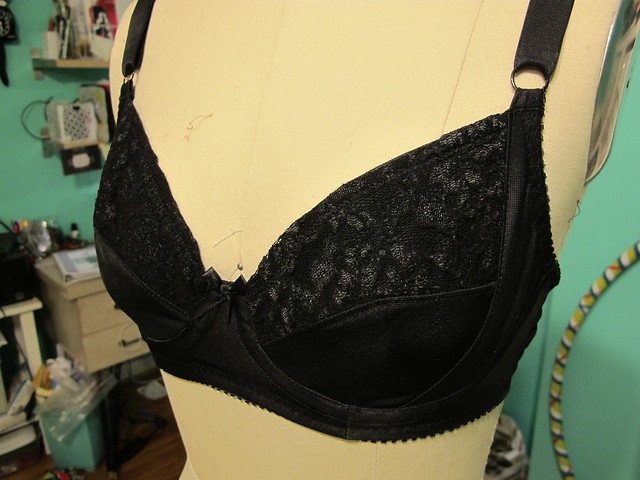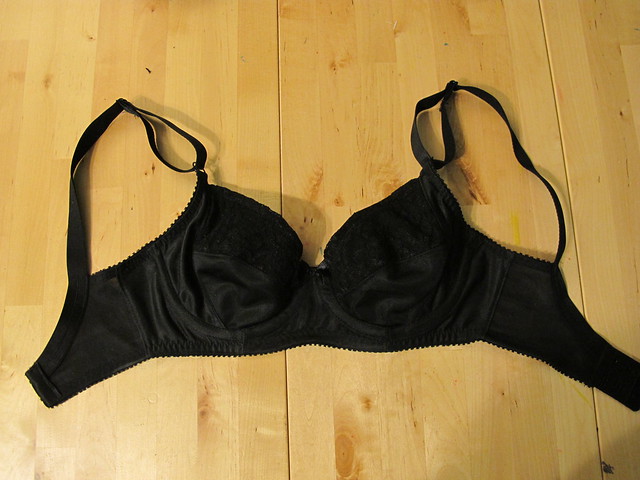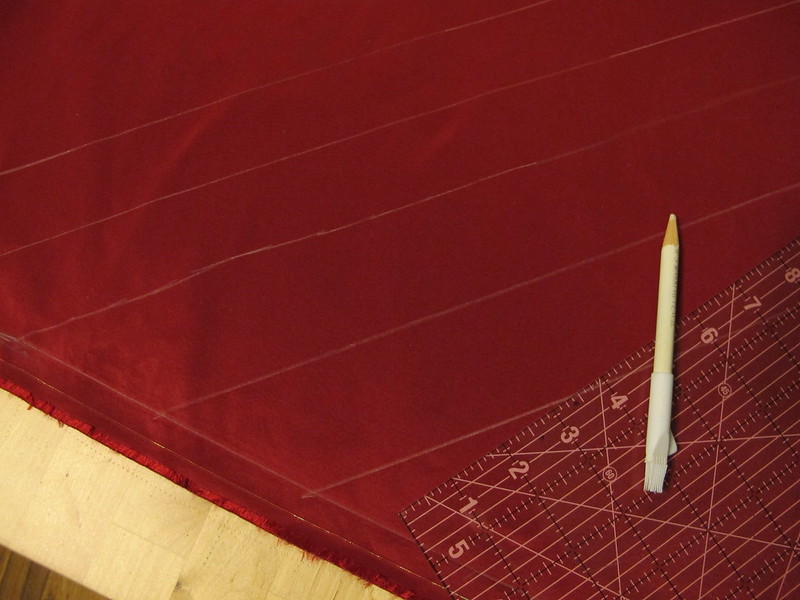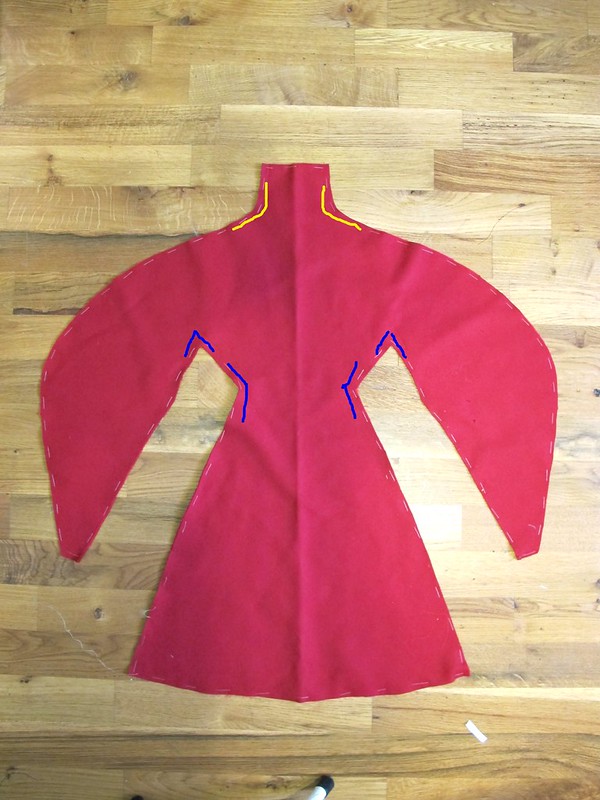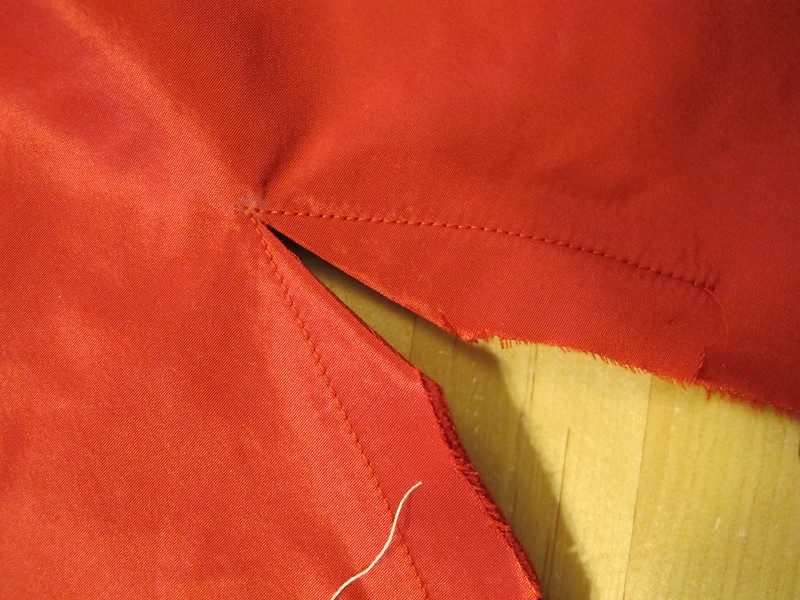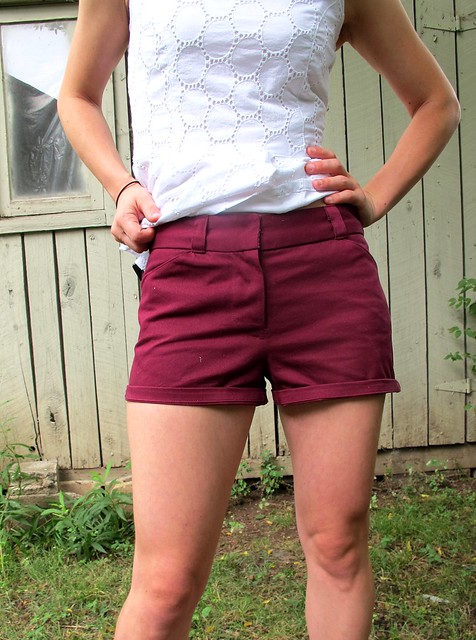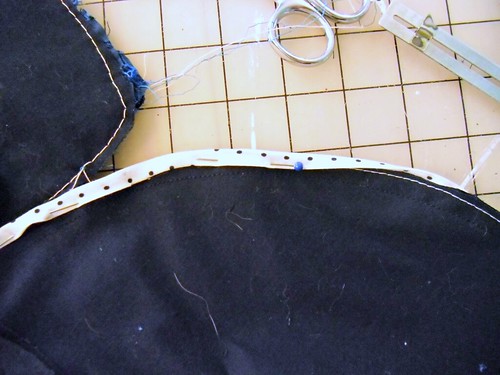Omg, you guys! I made a bra!
And not only that – it actually fits! It’s comfortable! And it’s PRETTY!
Besides the little bralettes I played around with a couple months ago (which totally don’t count), this is actually the first bra I have ever made. The VERY first – it started as a wearable muslin, that is quite super duper wearable. In fact – wearing it as I type this! Can you tell how tickled I am with this turn of events? SUPER pleased with myself right now.
Ok, lemme back up a little bit and talk about the not-so-harrowing process of bra-making. The pattern I used to make this gorgeous gal is the Marlborough Bra from Orange Lingerie. I can’t even tell you how happy I am about the release of this pattern – after reading up on Norma’s (of Orange Lingerie) book Demystifying Bra Fitting and Construction after she sent me a copy a couple of months ago (as well as lurking hard on the beautiful custom lingerie she makes), I knew the pattern itself would be amazing, both in terms of fit and instruction, not to mention overall style. Spoiler: the pattern absolutely did not disappoint.
While I’ve had this pattern in my stash for a little while now, it took me a couple of months to muster up the energy to actually make it up. There is a LOT of info in the pattern – as well as on the Orange Lingerie blog – about choosing fabrics and notions. Orange Lingerie’s book, Demystifying Bra Fitting and Construction, is also a great resource, with whole chapters devoted to all the fine details. I ended up chatting Norma up via email for advice on what fabrics to buy, and she directed me to Bra Makers Supply (psst – the US version is Sweet Cups Bra Supply. It confused me at first, too, but the shipping is a bit more reasonable for those of us in America. You can click over to the US site from the main site, on the top right hand corner). They actually sell full bra kits that include everything you need to make a bra – the fabric & powernet, all the elastics and notions, even a tiny bow 🙂 The Marlborough bra was designed to be made of a fabric that has no stretch, and specifically, designed for the fabric that comes in these kits. So I bought two kits right away. There are ways to manipulate any fabric to get it to work for this pattern (which is outlined here), but for my first bra, I wanted to Keep It Simple, Stupid.
A few of things I want to point out about these kits:
– They don’t come with underwires. You have to buy those separately. I bought them from the same site to save on shipping. If you don’t know your underwire size (I did not), get your best guesstimate based on your RTW size/measurements and buy the next size up or down. I bought both the 34 & the 36. I ended up using the size 34 for this bra.
– The kits also do not come with lace. You’ll need to supply that on your own. I was all set to make this bra with my red kit, until I realized I didn’t have any red lace! So I’ll be looking for red lace in London. In the meantime, the black lace leftover from my Georgia dress worked nicely for this bra 🙂
– While the kits do come with elastic strapping, be warned that it is NOT enough for this pattern (Maddie warned me to this, and I didn’t listen to her at all because I’m an asshole. Then I had to go back and buy more strapping. Except I bought it from a different supplier, and it was a MILLIMETER more wide than what I needed, so it’s kind of hard to slide the sliders and rings. Argh!). I think the kits are cut for bras with fabric straps. Anyway, you’ll want to buy more strapping – either from Bra Maker’s Supply, or another vendor entirely. You’ll need at least a yard and a half, and the kits come with something crazy like 15″.
– Be mindful of what size kit you are buying. My bra cups are preeeeetty small, so I bought the small kits since I wanted to save on shipping as they weigh a tiny bit less. That fabric yardage worked out great, however, I didn’t think about the fact that my size really needs a 3 hook hook and eye! The small only comes with the 2 hook size. It’s not the end of the world (my bra is perfectly supportive with the 2 hooks), but you will need to recut the back band to fit the smaller size if that’s the case. Just fyi!
– I’ll also mention that the fabric that came in the kits, at first glance, looked really cheesy and cheap. It was REALLY shiny and my first impression was that it looked like a crappy Halloween costume. Ha! For one, you can use either side of the fabric (my shiny side is on the inside, so my bra is more matte). Also, it’ll look better when it’s sewn up. Just looking at a flat, shiny piece of fabric… well, it’s gonna look shitty no matter what. So there’s that.
– Speaking of shipping, Bra Maker’s Supply did refund me about half my shipping costs after they sent my order out. That kind of ruled!
Based on my measurements and Norma’s email advice, I decided to make the size 30D. I typically wear a size 28DD or 30D in RTW, so pretty much the same. I actually compared the pattern pieces to my favorite lace RTW bra to see if they were similar, and they were almost exactly the same. Fit-wise, things are very close. The upper cups on my handmade bra are a little more snug than the RTW one, but the RTW one also has stretch lace for the upper cup (whereas on the Marlborough, the lace is rigid), so that might have something to do with it.
The Marlborough Bra pattern is very well-written and covers every step of the process, which is super helpful if you’re like me and have never sewn a bra before. There are tips on where to add topstitching, how to sew in the underwire channels perfectly, what pieces to baste on first so they don’t slip when you zigzag them on. In itself, the pattern is absolutely sufficient for making a bra. However, I did find it incredibly helpful to have Norma’s book at my side during the process. Whenever I found a step in the pattern confusing (more so confusing because this was new and alien territory to me – and less because the instructions were lacking), the book answered it right away. It’s also helpful because there are actual photos of the steps in the book, so if the diagrams aren’t doing it for you, you have back-up. Of course, I don’t think it’s necessary to have the book to make a bra – but I was happy to have it on hand.
The one part about the pattern that I didn’t like was that it wasn’t super clear on what pattern pieces to cut from what fabric. This stalled me for a couple of hours, actually – there’s some general info in the pattern, but I’m the kind of person who needs clear-cut specifics. After googling as many Marlborough bras as I could find, pouring over Norma’s book, and referencing Maddie’s bra-making guide from her Sewing Party class, here’s what I came up with:
– The cups, bridge and frame are cut from the main fabric from my kit. I cut them according to the grainline, since there is a slight stretch in the fabric.
– The straps were cut out of powermesh, with the direction of greatest stretch (DOGS) running around my body.
– Since my lace is stretchy, I lined it with more of my black fabric so it would be rigid (as the pattern calls for)
– I lined the bridge with a second layer of the same black main fabric
The kits also don’t tell you which elastic is for what. I wish I’d bothered to figure that out BEFORE I started sewing – as there is actually a cute little 1/4″ scalloped/lace trim for the upper cup. Instead, I used clear elastic on the inside of my cups. Womp womp. At any rate, I figured out the rest of the elastics pretty easily – just measure them and check the widths against the pattern notions list. One thing to keep in mind, again, is that the small kit has narrower trims. Since my size is a D, I should have had the large kit (and wider elastics, including straps). I did not, but the bra turned out fine. I feel supported.
Oh, and I did not finish my seams. I felt that focusing on construction and fit was more important for this go. I do want to explore seam finishing for future bras, though!
All this aside, I had a LOT of fun putting this thing together! Omg! Once the cups were assembled, it really started to look like a bra and that’s when things got exciting. I got to usse all kinds of cool zigzag stitches (these are all covered in the pattern instructions) and play around with lace and trims. So fun! One tip I will give is to be careful with those 1/4″ seam allowances – if you’re not used to sewing them (I’m not), you might have issues with the machine trying to eat the edge of your fabric, especially if you’re sewing something delicate. I have found that by *very* gently pulling the thread tails away from you when you start each seam, it will guide the fabric along until your feed dogs have a good grip and you’re past the danger of your machine chomping a hole in your fabric. Just be sure to hold both thread tails and don’t force it.
Also, that favorite RTW bra that looks a lot like this one? I kept it on hand while I was sewing my Marlborough, so I could refer to it when needed. That was pretty helpful, especially when I needed to visualize how the elastic was supposed to look.
The only downside to bramaking is, unfortunately, it’s very hard to tell if the bra will fit until it’s mostly finished. Of course, you can mock-up with crappy elastics and temporary underwires, but because the fabric is so essential to determining fit, the mock-up needs to be of the same stuff (aka, not cheap muslin, or whatever). So it’s a bit of a gamble. I’m pretty thrilled that mine fits so well – although it can definitely use a little bit of tweaking before it’s perfect. I’ll let y’all know how that goes! In the meantime, here’s a somewhat awkward photo of how this one fits on me:
Sorry that I had to totally erase my body (I’m not terribly shy, but, this is a public blog, after all), but this should give you an ok idea of how it looks. I’m actually pretty impressed! It’s supportive, it’s comfortable, and it’s SO pretty! Looks like a bra you’d buy in a store. Except better, because I made it 😛 As far as wearing it under clothes – it’s about the same as any seamed/lace bra. Not completely smooth (personally, that doesn’t bother me), but not super lumpy. Since this fabric is kind of thick, I’ve noticed that nipping isn’t too much of a problem, either.
I’m looking forward to making more of these! Once I tweak the fit, I want to try some different kits – I see that Grey’s Fabric has some beautiful kits, and I’ve also been eyeballing the ones from Hooks & Wires. Not to mention the famous Merckwaerdigh kits, the holy grail of all that is beautiful about handmade lingerie. I want to buy all white everything and try my hand at dying the whole set to match (there’s a short chapter on dying in Demystifying Bra Fitting and Construction, yes!). I want to explore trying new fabrics (I’m thinking this might be the PERFECT excuse to splurge on a tiny piece of Liberty fabric while I’m in London!), laces and trims, and mixing and matching for some cray combinations. I want to make matching underwear (yep). I also want to make a push-up bra, but that may require a different pattern 🙂 Making this one bra just has me itching to sew more! It’s SO satisfying! Have I convinced you to make a bra yet? Have I? Huh? 🙂
Bloggy Disclaimer: Norma sent me a copy of Demystifying Bra Fitting and Construction as a gift. I did buy the pattern and kits with my own money, just in case that wasn’t clear!
Ooh, speaking of London – a couple more things –
For those who have asked – there will be a meet-up on Saturday the 22nd! If you emailed me previously, you should have received the details of the meet-up a couple of days ago. Anyone else who wants to join (whether you didn’t contact me, or are just hearing about it now 🙂 ) – we will be meeting at Goldhawk Road at 10:00 AM. We will congregate outside the tube stop until 10 minutes after the hour, then we will be moving on to shop! If you would like to join the meet-up – please, come! You don’t have to email me to get an ~invite~ (nor do you need to have a blog to hang with us). If you can’t make it at 10:00 AM but would still like to try to find us later, you can either email me and I will give you my number (I plan on getting a SIM while I’m there, so it’ll be local!) so you can text me, or just tweet me. Come to buy fabric, come to eat and drink later – whatever works! This is an open invite 🙂
Also, the blog will probably be pretty quiet while I’m gone. I want to really enjoy my vacation and not be sitting at a computer all day! I will have access to the web and will respond to emails and comments as I can (and maybe squeeze a post in if I have downtime waiting at the airport or something), but I don’t have anything autoscheduled and I’m not bringing in guest posters or anything like that 🙂 I’m taking a break and I’ll be back in December! 🙂 In the meantime, if you want to lurk my trip – you can follow my Instagram and/or Twitter.
See y’all laterz!! ♥

